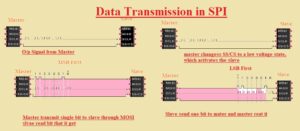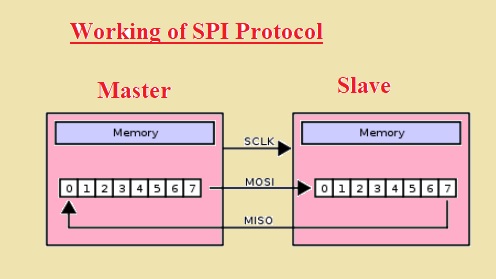 Hello, readers welcome to the new post. Here we will discuss Introduction to SPI Protocol. SPI stands for a serial peripheral interface that is a communication protocol used for communication for small distances such as in embedded systems like microcontrollers. It was first time used in mid of the 1980s and was created by Motorola. This protocol communicates with the use of full-duplex mode and master-slave configuration that has one master or control device.
Hello, readers welcome to the new post. Here we will discuss Introduction to SPI Protocol. SPI stands for a serial peripheral interface that is a communication protocol used for communication for small distances such as in embedded systems like microcontrollers. It was first time used in mid of the 1980s and was created by Motorola. This protocol communicates with the use of full-duplex mode and master-slave configuration that has one master or control device.
More than one salve or output device can be connected to this module through use of the slave select line. SPI is also called 4 wires serial bus.It can also define as a synchronous serial interface but not the same the SSI or synchronous serial interface that also uses four wires. In this post, we will discuss different paramerts of SPI protocols in detail. So let get started.
Introduction to SPI Protocol
- It is a commonly used communication four-wire system employed in numerous projects and embedded systems.
- Examples of devices that use SPI protocols such as wireless systems, RFID card readers SD card readers.
- Its main advantage is that it transmits the data without any hindrance. Different quantities of data bits can be transmitted and received in serial form.
- While in other communication protocols such as UART and I2c send and receive data through use of packets and has some restrictions.
- It is subnode configured synchronous interfacing.

- In the above figure, some terms are used that’s explanation is given
- MOSI is master output slave input it uses to send data to the slave
- MISO it indicates master input slave output it used for send data to the master from the slave
- SCLK clock used for clock signal
- SS/CS that is slave select chip select it helps to mater to choose which slave use for transmission of data.
Featues of SPI Communication Protocol
- Some features of this protocol are discussed here
- It consists of four wires for communications
- Data transfer speed for this protocol is about ten megabytes per second
- It is a synchronous protocol
- It also uses a serial communication system
- It has one master device and numerous slave devices can be connected
Working of SPI Protocol
- To send and receive data bust master arranges clock through use of frequency comported with slave modules to certain megahertz
- Master chooses the slave module through use of logic level zero at the select line.
- Some delays needed in different operations such as ADC master add some delay to send the clock signal
- Through the use of a very SPI clock signal, full-duplex communication is used for data transmission.
- Data in form of bit at the MOSI line sends by the mater read but the slave device. and Master gets the bit through the MISO line and reads it
- There are 2 shift registers having some word size is employed like 8 bits one for master and one for slave.
- Data transferred through use of most important bit firstly
- At the clock point master and slave shift the bit and send to result in a portion.
- At another side at every receiver point bit is sampled through the transmission line and adjusted in less important bit at the shift register
Data Transmission in SPI
- Some steps are followed to data transmit int he SPI

SPI Advantages
Main advantages of SPI are discussed here
- It is a duplex communication protocol
- Used of a push-pull driver in this module offered the high-speed operation
- Its speed is high than I2C and does not depend don’t the extreme clock speed.
- It not need eight-bit words
- Its structure is simple
- It uses less power to operate than other modules
- Its hardware structure is very easy to make
- Slaves devices uses the master signal and not required precision oscillators
- It does not need a certain address like other protocol
- It is four-pin module
- Any software can be easy to use on it
SPI DisAdvantages
- The main disadvantage of this protocol are discussed
- It needed more pins at board than other protocols such as I2c
- It needed of band chip select signal
- It does not have hardware flow control at the slave
- It can have a single master device
- There is no configuration of error interruption
- It does not fulfill the hot swapping
- Another category of SPI is half-duplex such as dual SPI Quad SPI
SPI Applications
- Common applications of SPI are described here
- It is used in different types of sensors such as pressure ADC temperature video games controllers
- It is used in DAC, audio condes that are a control device
- Used in lenses of a camera
- It uses in different communication systems such s USB, Ethernet CAN
- It consists of flash memory
- Real-time clocks
That is all about the SPI protocol that has been discussed with details. If you have any further queries ask in the comments. Thanks for reading







